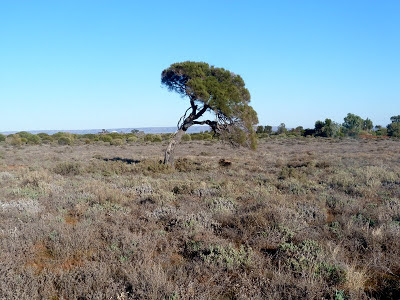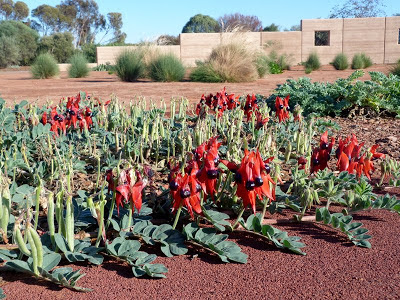Port Augusta, at the head of Spencer Gulf in South Australia, is a place where you need to make a big decision if you're coming from the east. You can turn right and head north straight through the middle of Australia for nearly 3,000 kilometres to Darwin on the north coast, or you can keep heading west for a more modest 2,400 kilometres to Perth. Personally I find each option almost irresistible, though often neither is very practical.
 |
| Port Augusta's location, at the end of the red arrow. |
However even if I'm not doing such an epic journey, whenever I go there I do head just a few hundred metres north along the Stuart Highway to one of my favourite botanic gardens. I have a few of these, and they have featured as a sporadic series on such gardens in the course of my blog. The most recent can be found here, with links further back; or you can just look up Botanic Gardens under Labels elsewhere on this page.
 |
| Entrance from the Stuart Highway, on the northern outskirts of Port Augusta. (Looking into the morning sun - sorry!) |
This is not in any way a conventional botanic garden (which of course is one reason I'm featuring it!); it covers some 200 hectares, much of which protects an important example of good quality arid vegetation. This comprises chenopod shrublands (saltbushes and bluebushes) with scattered trees, notably the beautiful wattle called Western Myall.
 |
| Old Western Myall Acacia papyrocarpa in chenopod shrublands, Arid Land Botanic Gardens. These trees are said to live for perhaps a thousand years. |
The story of the gardens began back in the late 1970s when the Port Augusta Superintendent of Parks and Gardens, John Zwar, undertook a study tour enabled by a Churchill Fellowship to examine dryland horticultural practices overseas. Enthused, he returned and proposed in 1981 that the local Council support the establishment of an arid lands garden; there were none in Australia then, though work was underway on the Olive Pink Botanic Garden in Alice Springs, which will feature here in the near future. The state-run Adelaide Botanic Gardens offered its valuable support, and even more importantly the public got enthused by the concept. (I'd just left South Australia then, so missed much of the excitement.) It was a long hard slog, and it wasn't until 1996 that it opened to the public, but I can't imagine there's anyone who doesn't think it's worth it.
Access is by road, though there are walking tracks both in the 'wild' area and the planted gardens around the visitor centre. I generally drive right across the site first, soaking up the ambience and checking what birds are flying around, to the splendid view across the head of Spencer Gulf to the superb Flinders Ranges, which feel like heartland to me.
In the midst of the plain, in a small stand of Western Myall and Sandhill Wattle Acacia ligulata, is an unexpected bird hide, featuring an artificial watering point.
 |
| The hide above, and the view from it (to the right of the top picture) below. |
A variety of arid land birds can appear, but Singing Honeyeaters Lichenostomus virescens are pretty reliable.
 |
| Singing Honeyeaters enjoying the facilities. |
From here too, the well-designed visitor centre, with its extensive plantings of Australian dryland plants, appears as a cluster of shrubs and low trees to the west, near the highway.
The picnic areas and plantings around the centre are delightful.
 |
| Plantings around the carparks (above) and one of the picnic areas (below). |
A feature of a courtyard is one of my favourite plants, the state symbol of South Australia.
 |
| Sturt's Desert Pea Swainsona formosa. |
 |
| Green Rattlepod Crotolaria cunninghamii; a striking pea of the inland red dunes. |
 |
| Halgania cyanea Family Boraginaceae |
One of the garden's prides is a superb collection of Eremophilas - emu-bushes, or poverty-bushes, whose apparent delicacy belie their incredible toughness, as they survive in some of the harshest parts of the continent. Emu-bush reflects the belief that seeds must pass through an emu's intestine to germinate, thought that is demonstrably untrue for many species. They are now generally regarded as being in the family Scrophulariaceae, though until recently they were placed in Myoporaceae.
 |
| Granite Eremophila Eremophila platycalyx, from the granite country of central Western Australia. |
 |
| Eremophila stenophylla from south-west Queensland. |
Next time you're passing through Port Augusta, do yourself a serious favour and spend at least an hour at this very special garden.
12 September 2014. I've become aware of a huge amount of interest in this posting over the past few days. Just for my interest, could someone tell what the impetus has been? Thanks! Either leave a comment below or contact me privately on calochilus51@internode.on.net. Thanks again, Ian
BACK ON FRIDAY






No comments:
Post a Comment